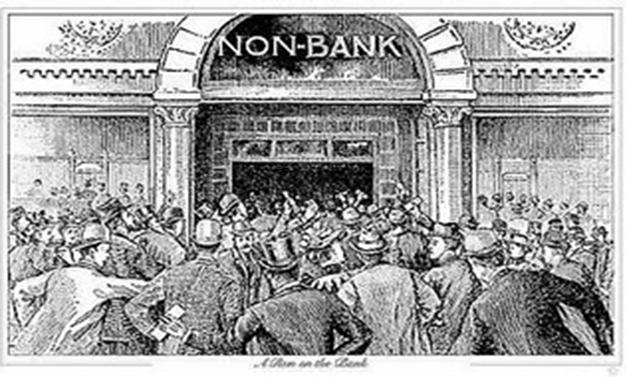via Wikipedia
Shadow Banking System
Shadow banking institutions are typically intermediaries between investors and borrowers. For example, an institutional investor like a pension fund may be willing to lend money, while a corporation may be searching for funds to borrow. The shadow banking institution will channel funds from the investor(s) to the corporation, profiting either from fees or from the difference in interest rates between what it pays the investor(s) and what it receives from the borrower.
By definition, shadow institutions do not accept deposits like a depository bank and therefore are not subject to the same regulations. Familiar examples of shadow institutions included Bear Stearns and Lehman Brothers. Other complex legal entities comprising the system include hedge funds, SIVs, conduits, money funds, monolines, investment banks, and other non-bank financial institutions.
The shadow banking system has been implicated as significantly contributing to the financial crisis of 2007–2010. In a June 2008 speech, U.S. Treasury Secretary Timothy Geithner, then President and CEO of the NY Federal Reserve Bank, placed significant blame for the freezing of credit markets on a “run” on the entities in the shadow banking system by their counterparties. The rapid increase of the dependency of bank and non-bank financial institutions on the use of these off-balance sheet entities to fund investment strategies had made them critical to the credit markets underpinning the financial system as a whole, despite their existence in the shadows, outside of the regulatory controls governing commercial banking activity. Furthermore, these entities were vulnerable because they borrowed short-term in liquid markets to purchase long-term, illiquid and risky assets. This meant that disruptions in credit markets would make them subject to rapid deleveraging, selling their long-term assets at depressed prices.
Nobel laureate Paul Krugman described the run on the shadow banking system as the “core of what happened” to cause the crisis. “As the shadow banking system expanded to rival or even surpass conventional banking in importance, politicians and government officials should have realized that they were re-creating the kind of financial vulnerability that made the Great Depression possible–and they should have responded by extending regulations and the financial safety net to cover these new institutions. Influential figures should have proclaimed a simple rule: anything that does what a bank does, anything that has to be rescued in crises the way banks are, should be regulated like a bank.” He referred to this lack of controls as “malign neglect.”
Read more about the Shadow Banking System here…
The report…
Federal Reserve Bank of New York
~
Staff Reports
~
Shadow Banking
~
Zoltan Pozsar
Tobias Adrian
Adam Ashcraft
Hayley Boesky
Staff Report no. 458
July 2010
This paper presents preliminary findings and is being distributed to economists
and other interested readers solely to stimulate discussion and elicit comments.
The views expressed in this paper are those of the authors and are not necessarily
reflective of views at the Federal Reserve Bank of New York or the Federal
Reserve System. Any errors or omissions are the responsibility of the authors.
Abstract
~
The rapid growth of the market-based financial system since the mid-1980s changed the nature of financial intermediation in the United States profoundly. Within the market-based financial system, “shadow banks” are particularly important institutions. Shadow banks are financial intermediaries that conduct maturity, credit, and liquidity transformation without access to central bank liquidity or public sector credit guarantees. Examples of shadow banks include finance companies, asset-backed commercial paper (ABCP) conduits, limited-purpose finance companies, structured investment vehicles, credit hedge funds, money market mutual funds, securities lenders, and government-sponsored enterprises.
Shadow banks are interconnected along a vertically integrated, long intermediation chain, which intermediates credit through a wide range of securitization and secured funding techniques such as ABCP, asset-backed securities, collateralized debt obligations, and repo. This intermediation chain binds shadow banks into a network, which is the shadow banking system. The shadow banking system rivals the traditional banking system in the intermediation of credit to households and businesses. Over the past decade, the shadow banking system provided sources of inexpensive funding for credit by converting opaque, risky, long-term assets into money-like and seemingly riskless short-term liabilities. Maturity and credit transformation in the shadow banking system thus contributed significantly to asset bubbles in residential and commercial real estate markets prior to the financial crisis.
We document that the shadow banking system became severely strained during the financial crisis because, like traditional banks, shadow banks conduct credit, maturity, and liquidity transformation, but unlike traditional financial intermediaries, they lack access to public sources of liquidity, such as the Federal Reserve’s discount window, or public sources of insurance, such as federal deposit insurance. The liquidity facilities of the Federal Reserve and other government agencies’ guarantee schemes were a direct response to the liquidity and capital shortfalls of shadow banks and, effectively, provided either a backstop to credit intermediation by the shadow banking system or to traditional banks for the exposure to shadow banks. Our paper documents the institutional features of shadow banks, discusses their economic roles, and analyzes their relation to the traditional banking system.
Key words: shadow banking, financial intermediation
Full report below…
~
4closureFraud.org
~
Federal Reserve Bank of New York Staff Report no. 458 July 2010
Click
–> Here <–
to Download Report


Why are we hereing more and more comments from the Privately Owned Federal Reserve that has fought audit after audit? Could it be that they are scared of the Wall Street reform bill that mandates an audit and are trying to pass blame now?
Stan
Racine, Wi